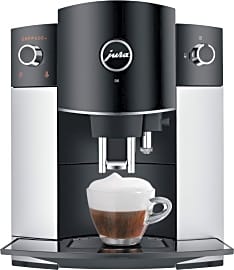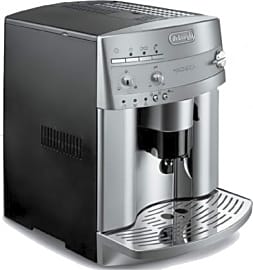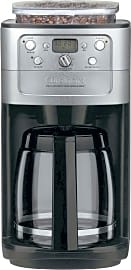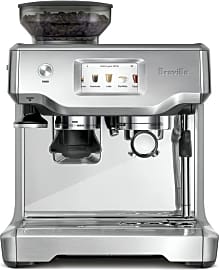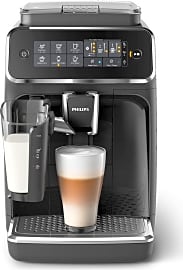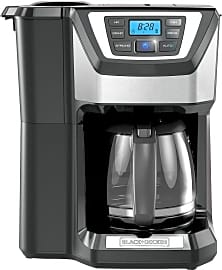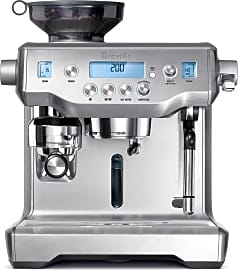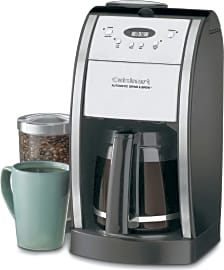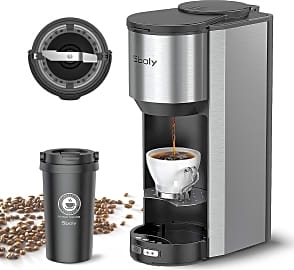The 10 Best Self Grinding Coffee Makers

This wiki has been updated 35 times since it was first published in December of 2016. Brewing and drinking the day's first cup of java is thoroughly rewarding, but it can also be awfully noisy and messy. After all, the best flavor comes from freshly ground beans, which require several time-consuming steps to prepare. One of these self-grinding coffee makers will streamline your morning process and provide you with a delicious cup in less time than you imagined was possible. When users buy our independently chosen editorial recommendations, we may earn commissions to help fund the Wiki.
Editor's Notes
October 31, 2020:
Each person has a different definition of what the perfect cup of coffee tastes like, and that's why the best options on this list can be adjusted based on your desires and the beans you've chosen to use. The Jura D6 has been added, and given a high position, because it can produce many types of drinks easily. Same goes for the Philips 3200 Series, which is ideal for users who don't want a lot of fuss but not great for those who want to tweak things.
The best machines on the list produce espresso as opposed to standard American drip coffee, and that's not an accident. While the Cuisinart DGB-700 is a simple option, and relatively inexpensive, it can't compete with the flavors generated by a top-notch espresso machine and milk frother. The Cuisinart Grind & Brew is another good budget choice, but watch out for the additional features. Adding the silver finish and thermal carafe can quickly make this one less of a bargain.
Most coffee snobs are willing to spring for an additional grinder that they deem worthy, and don't mind cleaning an extra unit if it means improved taste. Those in the market for a self-grinding machine are perhaps willing to sacrifice a little quality in the name of convenience, and that should hopefully translate into savings as well. That's why the Breville Barista Express is in the top spot, even though the Breville Touch and Breville Oracle have more features. If you're willing to plunk down enough for either of those, it's worth considering units without a grinder and picking up a separate machine for that function, because anyone who takes their coffee that seriously will appreciate being able to control every step of the process.
June 14, 2019:
The Cuisinart DGB-700 and the Breville Grind Control are both high quality choices that are ideal for your daily morning brew. We rated the Cuisinart a little higher because the Breville's thermal carafe can't offer a piping hot cup after 30 minutes or so, but you can extend it's warming time by pre-warming the carafe with boiling water.
The popularity of espresso drinks continues to increase, so we included several of the best espresso models because you can't pull a decent shot of espresso without freshly ground beans. The Breville Barista Express is reliable and will last for years but requires practice to find the perfect match of grounds and tamping pressure, but once mastered users will find themselves skipping the expensive coffee shops for their own home brew. We included the far more expensive Breville Oracle because the perfect shot is completely automated, but it'll take a lot longer to start saving you money.
Special Honors
DeLonghi Eletta Though it might set you back a bit, the DeLonghi Eletta makes things simple and precise for those who know what they want and are willing to spend for it. It's consistent, easy to clean, and can be operated with just the push of a button. delonghi.com
Bosch Built-In For most people, a coffee maker is an appliance you can swap in and out of the kitchen wherever you happen to reside. But for those building or remodeling a home, the Bosch Built-In can fit with your new kitchen design, offering a touch-screen interface and automatic cleaning - not to mention how great it looks. bosch-home.com
What's Actually Going On Inside My Coffee Maker?
The electric drip brewer was made to simulate the effect of manual pour-over brewing, but it did not supplant the practice, which remains popular today.
Coffee making technology hasn't changed much over the past several hundred years. To this day, there are just a handful of simple processes used to brew most coffee, regardless of whether it's being made with a simple plastic funnel or in a fancy machine that costs a great deal. Of course, there's plenty of subtle variation from one machine to another, but the basic processes don't change much from one coffee maker to the next.
The most common type of coffee machine is the electric drip brewer, which Gottlob Widmann invented in Germany in 1954. In a drip brewer, water is first poured in a dedicated chamber. It is then heated in small quantities, while thermally-induced pressure forces it to the next step, where it is fed through a spray head into what is called a brew basket. This chamber contains coffee grounds, usually in some sort of filter. The water is introduced gradually, steeps in the grounds, and slowly drips through them into a carafe.
The electric drip brewer was made to simulate the effect of manual pour-over brewing, but it did not supplant the practice, which remains popular today. Instead, it largely replaced the electric percolator, which had been in use since the turn of the century. Percolators use a heating element to boil a pot of water, which is forced into a brew basket where it mixes with the grounds before dripping back into its original pot. This cycle continues until the entire pot reaches the desired strength. By the 1970s, the electric percolator had largely fallen out of favor.
The oldest machines used for making coffee are vacuum brewers. Usually a larger apparatus designed for making large quantities of coffee at a time, the vacuum brewer uses pressurized chambers to get its job done. Water is heated in the lower chamber until the heat forces it into an upper section containing coffee grounds. Once the lower chamber is fully emptied and the water has had enough time to mix with the grounds, the heat is turned off. This creates a vacuum effect in the lower chamber, which forces the liquid back down, usually passing through a strainer on its way.
Before the 19th century, coffee was typically brewed in a pot of boiling water, either in an infusion bag or strained once brewing was complete. Other methods, like the moka pot, also known as the stovetop espresso maker, and the French press, weren't developed until the 20th century, despite their non-electric designs. Even the manual pour-over method wasn't popularized until after 1908, when German inventor Melitta Bentz developed the paper coffee filter.
The Benefits Of Brewing From Fresh-Ground Beans
For the vast majority of coffee drinkers who brew their own at home, the beans they're using were ground in a factory sometime long before they are used. There is a healthy market for coffee grinders large and small, manual and electric, in virtually every style you can imagine, but for most people it's a major hassle to buy a whole separate device just to crush up your coffee when it's so easy to simply buy pre-ground.
The beans' shelf-life also decreases dramatically, and they can easily go rancid if left unused for long.
True coffee connoisseurs, however, know that nothing compares to a cup of joe made from freshly ground beans, regardless of the brewing process. Aside from elitism, there are plenty of more scientific reasons why freshly ground beans make the best brew.
While whole roasted beans have shells that keep everything contained therein relatively fresh, once ground they can no longer protect their contents. When the delicate oils in coffee are exposed to the elements, they are prone to a number of undesirable outcomes. They can easily pick up smells and flavors from other matter nearby. They are also water soluble, so any moisture in their environment can degrade them rapidly. Finally, they can be easily contaminated through contact with other substances. The beans' shelf-life also decreases dramatically, and they can easily go rancid if left unused for long.
Another enemy of ground coffee is oxidation. Once the insides of a coffee bean are exposed to the oxygen in the air, they start changing rapidly. It is said that coffee loses about 60 percent of its aroma within 15 minutes of being ground. That's probably the greatest benefit of a machine that grinds the beans immediately before brewing; it cuts down on the time between grind and brew as much as possible, while also limiting the grounds' exposure to air.
What To Look For In A Self-Grinding Machine
There are many key factors of self-grinding machines that are important to consider before deciding on which one is right for you. These include grinding method, brew settings, filtration, and storage.
A machine that offers a lot of user control may also allow you to choose the water temperature for further fine-tuning of your finished cup.
There are a variety of grinder styles that you may use. Most machines use burr mills, which consist of abrasive surfaces rotating in opposite directions. While some machines will only have a single grind setting, if you're serious about your coffee, you'll want one that offers a bit more control. Even among drip coffee makers, there is a range of suitable grind-levels, and the finer the grind, the stronger the brew.
A machine that offers a lot of user control may also allow you to choose the water temperature for further fine-tuning of your finished cup. It's a good idea to experiment with these settings if you purchase a machine that offers them so you can find the one that best suits your tastes. You should also consider whether you want a coffee maker with a delay timer so that you can schedule your brew in advance.
Some machines require paper filters, while others use permanent ones, usually made of metal. Filter choice can affect the taste of your brew, so choose carefully. Remember that even if you choose a machine with a permanent filter, you'll have to remove and empty it between uses.
Finally, what kind of container do you want your machine brewing into? Glass carafes are classic and practical for seeing how much of your pot is left, but they do not retain heat well. If that's your priority, it's a good idea to go with something insulated.


